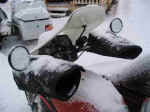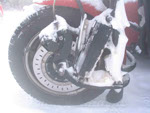
Take driving up North Serious. The ultimate recovery strategy to get back to normal temperature after a cold biking day is a hot sauna and a cold beer. To make it through to that point, take the below serious. Frost-bite and inability to see the road sounds very heroic, but a bit of preparation can do miracles and prevent medical disasters. Below a listing of battle proven stuff and "strategies".
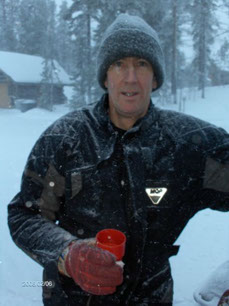
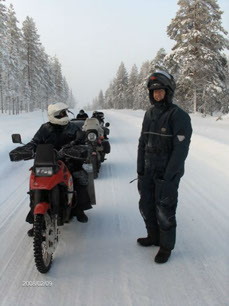

WINTER GEAR
example of fleece underall "Pro-Rainer - Björn"
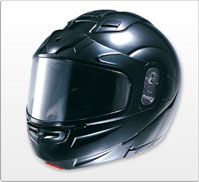
HJC Helmets
HJC Sy-Max Double paned and electrical heated visor. Lifesaver (no frostbite on face (due to driving with the visor cracked open a bit..), no frozen eyes, and you can actually see !!) Canadians use these on their Ski-Doo-s. Battle proven up north. Very attractive price and nearly only off-the-shelf heated visor still around on this planet.
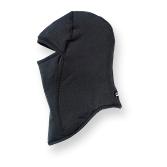
Use the helmet together with a face mask. Try to get a fleece one, like ice-fishers use in Canada, not the summer silk or cotton ones that get sold in Europe. These are gimmicks to keep your helmet clean, not to keep you warm..."contact us" for info how to get these.
Personal Equipment:
- The very basics: Don´t eat yellow snow!
- A heated visor, heated grips and heated socks work miracles and nearly essentials. Stay away from other heated garments. With these on you start usually to dress to thin underneath, so when you get an electrical problem or stuck in the snow ( seems to happen ones in a while...;-)) you cool off to much too fast. You might have to stick it out for a couple of hours in case of a problem....Usually legs, body and your butt are not areas to worry about if dressed ok. Your battery will wear out sooner than you, and you will also prevent becoming the wired-clown of the group...
- Frost bite in general: The "rule of thumb": As long as your fingers, feet, face still hurt, you are usually still ok...when you stop feeling pain you are in serious trouble. Your eye freeze up rather fast. As a warning sign you will notice a fraction of time between giving your eyes the brain command to blink and the time it actually happens. Also the autofocus function of your eye goes... Take signs serious ! Some veterans with black spots on their cheeks have been spotted...
- Funny, but helmet visors freeze on the inside, and cannot be reached easily to scrape off ! Both driving with iced visor or trying to scrape it off during driving are lethal activities. Ice inside visor is home-made...due to breathing. Driving with a non heated visor cracked open for ventilation works rarely (better said not at all), but is dangerous, resulting in frost bite on your face, freezing eyes. Alternative of not breathing for longer periods of time is not recommended. Ice and snow on the outside of the helmet are pretty harmless...since they can be easily removed while driving. Make sure your visor is always near clinically clean on the inside before setting out for a cold ride. That way ice forming is a lot slower because of absence of particals that act as "seed" for ice-cristals. Most bike shops sell special visor cleaner, but normal dishwashing detergent works pretty good as well. A helmet with double visor, as used for snowscootering works pretty good - see futher below in this article - "Contact us" for info on how to get one..
- We have driven through some very funny wheather conditions: minus 15 deg C and fog or just below zero with all kind of wet snow, fog, sand and salt (we call that "MEUK") flying around. For those conditions we did not find any decent solution yet, but take deep breath and smile because you now realise you are indeed on the hardcore trip you always wanted to be on...
- Double paned visors, even not electrical heated work well up to low temperatures.
- Pin-Lock visors work to -10C. Below that they freeze up on the inside, unless you hyperventilate like a madman inside your helmet like you are having a good time with Pamala Anderson (or the likes)) - which you can do for about 10 minutes eh ?. Ie pin lock is not really recommendable at low temeratures.
- Sun glasses - a must. Sun on snow is not a good combination. Make sure the glasses are very clean, otherwise they freeze up very fast.. also beware of drivig off with warm glasses under your helmet and find out that after you are just on the icy road your glasses get cold very fast, if not the coldest point under your helmet, making them resemble the Anti-Peril glasses mentioned in the Hitchikers Guide to the Universe... ie due to them being cold, your breathing moinsture settles on the glasses and - bingo - you see nothing anymore....very funny when that happens, I can tell you. Funny manouvers to stop, bugging people behind you (with hopefully clean visors) asap are the result....
- Long underwear is a good start to keeping warm. No need to spend a lot of money on high-tech fibers though. It is very rare to break a sweat on these trips. The house-brands from larger bike shops do just fine.
- As a second layer, wearing a one piece fleece underwear-suit like Helly Hansen sells (with sanitary stop zipper all around the back botttom..) is brilliant. Old russian tank-crew underwear-suits also work ok (although they make you look like a teddybear when running around with them on the ferry). You might have to roam around on the Internet a bit to find them (ice fishing, off shore equipment, sailing equipment sites..search for "fleece underall, faserpelz"...)
- Thermo boy overalls or similar off-shore workers overalls are excellent as top layer. Difficult to get sometimes though. And usually not 100% waterproof. But, hey, when it is -20 it is very rare to get wet. Normal motorbike suits are ok as well, but make sure you have "very loose fit", ie buy teh biggest size you can wear without impairing your ability to climb on your bike, other wise you cannot put on the required layers underneath or cannot move anymore when you do manage. This means that you should totally ignore what the sales persons tells you in the shop...just buy the biggest size you can get... you are not after a fashion statement here..
- If your suit has knee protectors, it pays to wrap / stuff additional insulating layers in or around those. Knees get cold...
- Wear a high wind and water proof "false collar". Obtainable at each decent bike shop. Do not pull collar over your mouth and nose if you already wear a face mask...with two layers of "windstopping stuff" your oxygen levels might start to drop rather drastically :-)) Did it, bin there...
- Using a knee cover/blanket works ok to keep the engine heat captured, but bit of a hassle to put on. Mostly "home made" designs are spotted. Just make sure the material cannot melt and is still souple when it is very very cold...and does not block your engine cooling system.
Muffs in combination with heated grips and some thinner summer gloves are the proven way to keep warm. Heated grips with winter gloves (and no muffs) don´t work well. Wintergloves insulate, remember, so heated grips just do not get through or at best keep the inside of your hands warm..outside still freezing stiff... with thin gloves and remembering the function of the now-hidden knobs and buttons of your bikes controls inside out, you are ok !
As a bonus closing your muffs at stops / night keeps the controls from freezing / blocking...yes, remember...do close the muffs at night. Finding them filled with snow in the morning has the very much opposite effect on your controls...
These guys are based in Canada and make tailormade muffs (Lenkerstulpen, moffen). Not the universal ones that never fit, and not as expensive as some of the alternatives.
They also makes nice shock protectors with EZon off with Velcro. See below in action on my K100.

"Contact us" if you are interested. Handcarry to Europe can be organised. For winter nerds only !
12V Heated socks - nearly a must...best thing is to buy the "controller" as well. Otherwise socks are just to hot. You might get the wire pattern grilled on your feet. Socks should not be used to walk in / on for long time. The wires start to move around in the wool otherwise. Correcting this is easy though, through some post or pre winter old fashioned sewing...if treated with respect they last for years.
When it is (very very) cold but dry. These kind of boots are the thing to wear. Not waterproof for a long time, but ultra cold proof. Just a bit harder to switch gears. You will need to adjust the level of your gear switch lever waaay up. "Contact us" for info on how to get these at reasonable prices.

